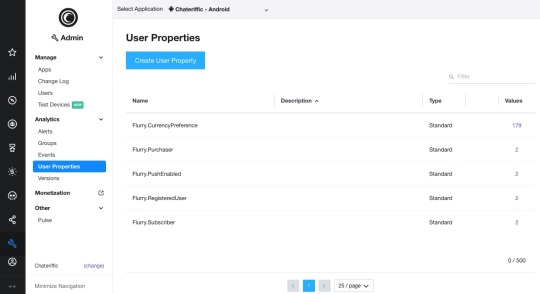Flurry now offers User Properties, which allow you to label your users based on their preferences, behaviors or attributes unique to your app to run deeper analysis. Let’s take a look at how User Properties can help you better understand usage, measure retention, and target push notifications.
Usage
Let’s say you have an app where users follow different topics, such as Technology, Entertainment, Sports and Politics. You would first create a User Property for all users that follow any topic, followed by a value for each of the four topics. Then, use Flurry to measure usage and engagement by topic.

Retention
You can also use User Properties to better understand user retention for specific cohorts. For example, with the Flurry mobile app (available on iOS and Android), we are most interested in understanding the retention of users who log into the Flurry App, versus those who have never logged in. So when a user logs in, we assign the User Property “LoggedInUser” with Value “True”. Then, we use Flurry to track retention for only these users by filtering on the User Property “LoggedInUser: True.”
This is one reason we offer five standard User Properties out of the box: Purchaser, Subscriber, Registered Users, PushEnabled and Currency Preference. Use these standard properties to run retention or any other analysis on these cohorts. you can also register an additional 50 custom User Properties and up to 500 custom User Property values.
Push Targeting
User Properties also can help you deliver more relevant push notifications. For example, your app may offer subscriptions or some type of paid tier. Set User Properties to enable you to target certain types of push notifications to paid users and send other notifications—perhaps nudges to transition to the subscription tier—to non-subscribers.
Another common push use case is user preferences. Let your users tell you the types of push notifications they want to receive, then use User Properties and Flurry Push Targeting to deliver the right messages.
Note that Push Targeting will be available in the coming weeks. We’ll also be rolling User Properties into Funnels, Segments and elsewhere so now is the time to determine which User Properties make sense for your app and to get started with your implementations.
Getting Started
To take advantage of Flurry User Properties, download the latest Flurry SDK and register your properties in the new User Property admin section of Flurry. Standard User Properties will automatically be available in reporting, while custom user properties must first be registered.

From there, you can apply your User Properties throughout the Flurry Developer Portal.
Please see here for full documentation and reach out to us with feedback or questions at support@flurry.com.